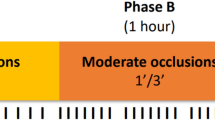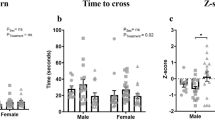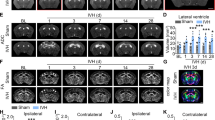Abstract
Umbilical cord occlusion (UCO), a known risk factor for perinatal brain damage, causes severe fetal asphyxia leading to oxidative stress, lipid peroxidation, and cell death. We have determined the effects of two 10-min UCO on the distribution of the lipid peroxidation marker 4-hydroxynonenal (4-HNE) and the activated form of the apoptosis marker caspase-3 in the brains of late-gestation fetal sheep. UCO caused asphyxia, hypertension, and bradycardia, but these parameters normalized 2 h after the occlusion. At postmortem, 48 h after the second UCO there were significantly higher numbers of 4-HNE–positive cells in all layers of the hippocampus and cerebellum, the parietal cortex, substantia nigra, caudate nucleus, putamen, and thalamus compared with control brains. 4-HNE immunoreactivity was also found in white matter tracts of the subcallosal bundle, external medullary lamina, reticular thalamic nucleus, and cerebellar fiber tracts only in UCO brains. Double-labeling identified these cells as predominantly neurons and astrocytes, with oligodendrocytes showing lower levels of 4-HNE immunoreactivity. After UCO, the number of caspase-3-immunoposotive cells was increased significantly in the hippocampal CA1, molecular layer and dentate gyrus, ventrolateral thalamic nucleus, substantia nigra, putamen, and cerebellar granular and molecular layers compared with controls. Double-labeling revealed caspase-3 immunoreactivity was mainly in neurons, and to lesser extent in astrocytes and oligodendrocytes. Pyknotic cell numbers were significantly increased in hippocampal CA1 and CA3, parietal cortex, caudate nucleus, putamen, and cerebellar Purkinje cells after UCO. These data indicate that brief asphyxia induces widespread lipid peroxidation involving all cell types of the fetal brain and apoptosis in both neurons and glia.
Similar content being viewed by others
Log in or create a free account to read this content
Gain free access to this article, as well as selected content from this journal and more on nature.com
or
Abbreviations
- UCO:
-
umbilical cord occlusion
- 4-HNE:
-
4-hydroxynonenal
- ROS:
-
reactive oxygen species
- TBARS:
-
thiobarbituric acid-reactive substances
- PFA:
-
paraformaldehyde
- NGS:
-
normal goat serum
- GFAP:
-
glial fibrillary acidic protein
- CNPase:
-
2′, 3′-cyclic nucleotide 3′-phosphodiesterase
- MAP-2:
-
microtubule associated protein
References
Volpe JJ 2001 Perinatal brain injury: from pathogenesis to neuroprotection. Ment Retard Dev Disabil Res Rev 7: 56–64.
Berger R, Garnier Y 1999 Pathophysiology of perinatal brain damage. Brain Res Brain Res Rev 30: 107–134.
Dammann O, Durum S, Leviton A 2001 Do white cells matter in white matter damage? Trends N. eurosci 24: 320–324.
Phillis J 1994 A radical view of cerebral ischaemic injury. Prog Neurobiol 42: 441–448.
Chandra J, Samali A, Orrenius S 2000 Triggering and modulation of apoptosis by oxidative stress. Free Radic Biol Med 29: 323–333.
Esterbauer H, Schaur RJ, Zollner H 1991 Chemistry and biochemistry of 4-hydroxynonenal, malonaldehyde and related aldehydes. Free Radic Biol Med 11: 81–128.
Maulik D, Zanelli S, Numagami Y, Ohnishi ST, Mishra OP, Delivori a-Papadopoulos M 1999 Oxygen free radical generation during in-utero hypoxia in the fetal guinea pig brain: the effect of maturity and of magnesium sulfate administration. Brain Res 817: 117–122.
Bagenholm R, Nilsson UA, Gotborg CW, Kjellmer I 1998 Free radicals are formed in the brain of fetal sheep during reperfusion after cerebral ischemia. Pediatr Res 43: 271–275.
Masaoka N, Hayakawa Y, Ohgame S, Sakata H, Satoh K, Takahashi H 1998 Changes in purine metabolism and production of oxygen free radicals by intermittent partial umbilical cord occlusion in chronically instrumented fetal lambs. J Obstet Gynaecol Res 124: 63–71.
Ikeda T, Choi BH, Yee S, Murata Y, Quilligan EJ 1999 Oxidative stress, brain white matter damage and intrauterine asphyxia in fetal lambs. Int J Dev Neurosci 17: 1–14.
Bennet L, Rossenrode S, Gunning MI, Gluckman PD, Gunn AJ 1999 The cardiovascular and cerebrovascular responses of the immature fetal sheep to acute umbilical cord occlusion. J Physiol 517: 247–257.
Ikeda T, Murata Y, Quilligan EJ, Choi BH, Parer JT, Doi S, Park SD 1998 Physiologic and histologic changes in near-term fetal lambs exposed to asphyxia by umbilical cord occlusion. Am J Obstet Gynecol 178: 24–32.
Kruman I, Bruce-Keller AJ, Bredesen D, Waeg G, Mattson MP 1997 Evidence that 4-hydroxynonenal mediates oxidative stress-induced neuronal apoptosis. J Neurosci 17: 5089–5100.
McCracken E, Valeriani V, Simpson C, Jover T, McCulloch J, Dewar D 2000 The lipid peroxidation by-product 4-hydroxynonenal is toxic to axons and oligodendrocytes. J Cereb Blood Flow Metab 20: 1529–1536.
Urabe T, Yamasaki Y, Hattori N, Yoshikawa M, Uchida K, Mizuno Y 2000 Accumulation of 4-hydroxynonenal-modified proteins in hippocampal CA1 pyramidal neurons precedes delayed neuronal damage in the gerbil brain. Neuroscience 100: 241–250.
Martin LJ, Brambrink AM, Price AC, Kaiser A, Agnew DM, Ichord RN, Traystman RJ 2000 Neuronal death in the newborn striatum after hypoxia-ischemia is necrosis and evolves with oxidative stress. Neurobiol Dis 7: 169–191.
Northington FJ, Ferriero DM, Graham EM, Traystman RJ, Martin LJ 2001 Early neurogeneration after hypoxia-ischemia in neonatal rat is necrosis while delayed neuronal death is apoptosis. Neurobiol Dis 8: 207–219.
Yamamoto T, Shibata N, Muramatsu F, Sakayori N, Kobayashi M 2002 Oxidative stress in the human fetal brain: an immunohistochemical study. Pediatr Neurol 26: 116–122.
Jelinski SE, Yager JY, Juurlink BH 1999 Preferential injury of oligodendroblasts by a short hypoxic-ischemic insult. Brain Res 815: 150–153.
Kohlhauser C, Mosgoller W, Hoger H, Lubec B 2000 Myelination deficits in brain of rats following perinatal asphyxia. Life Sci 67: 2355–2368.
Skoff RP, Bessert DA, Barks JD, Song D, Cerghet M, Silverstein FS 2001 Hypoxic-ischemic injury results in acute disruption of myelin gene expression and death of oligodendroglial precursors in neonatal mice. Int J Dev Neurosci 19: 197–208.
Mattson MP, Fu W, Waeg G, Uchida K 1997 4-Hydroxynonenal, a product of lipid peroxidation, inhibits dephosphorylation of the microtubule-associated protein tau. Neuroreport 8: 2275–2281.
Neely MD, Sidell KR, Graham DG, Montine TJ 1999 The lipid peroxidation product 4-hydroxynonenal inhibits neurite outgrowth, disrupts neuronal microtubules, and modifies cellular tubulin. J Neurochem 72: 2323–2333.
Subramaniam R, Roediger F, Jordan B, Mattson MP, Keller JN, Waeg G, Butterfield DA 1997 The lipid peroxidation product, 4-hydroxy-2-trans-nonenal, alters the conformation of cortical synaptosomal membrane proteins. J Neurochem 69: 1161–1169.
Back SA, Luo NL, Borenstein NS, Levine JM, Volpe JJ, Kinney HC 2001 Late oligodendrocyte progenitors coincide with the developmental window of vulnerability for human perinatal white matter injury. J Neurosci 21: 1302–1312.
Oppenheim RW 1991 Cell death during development of the nervous system. Annu Rev Neurosci 14: 453–501.
Mooney SM, Miller MW 2000 Expression of bcl-2, bax, and caspase-3 in the brain of the developing rat. Brain Res Dev Brain Res 123: 103–117.
Tenneti L, Lipton SA 2000 Involvement of activated caspase-3-like proteases in N-methyl-D-aspartate-induced apoptosis in cerebrocortical neurons. J Neurochem 74: 134–142.
Shibata M, Hishara S, Hara H, Yamawaki T, Fukuuchi Y, Yuan J, Okano H, Miura M 2000 Caspases determine the vulnerability of oligodendrocytes in ischemic brain. J Clin Invest 106: 643–653.
Han BH, DCosta A, Back SA, Parsadanian M, Patel S, Shah AR, Gidday JM, Srinivasan A, Deshmukh M, Holtzman DM 2000 BDNF blocks caspase-3 activation in neonatal hypoxia-ischemia. Neurobiol Dis 7: 38–53.
Liedtke W, Edelmann W, Bieri PL, Chiu FC, Cowan NJ, Kucherlapati R, Raine CS 1996 GFAP is necessary for the integrity of CNS white matter architecture and long-term maintenance of myelination. Neuron 17: 607–615.
Gunn AJ, Parer JT, Mallard EC, Williams CE, Gluckman PD 1992 Cerebral histological and electrophysiological changes after asphyxia in fetal sheep. Pediatr Res 31: 486–491.
Mallard EC, Gunn AJ, Williams CE, Johnson BM, Gluckman PD 1992 Transient umbilical cord occlusion causes hippocampal damage in fetal sheep. Am J Obstet Gynecol 167: 1423–1430.
Mallard EC, Williams CE, Johnson BM, Gluckman PD 1994 Increased vulnerability to neuronal damage after umbilical cord occlusion in fetal sheep with advancing gestation. Am J Obstet Gynecol 170: 206–214.
Mallard EC, Williams CE, Johnson BM, Gunning MI, Davis S, Gluckman PD 1995 Repeated episodes of umbilical cord occlusion in fetal sheep lead to preferential damage of the striatum and sensitize the heart to further insults. Pediatr Res 37: 707–713.
Acknowledgements
The authors thank Alex Satragno for his invaluable surgical expertise.
Author information
Authors and Affiliations
Corresponding author
Additional information
Supported by a grant from the National Health and Medical Research Council of Australia (D.W.W.).
Rights and permissions
About this article
Cite this article
Castillo-Meléndez, M., Chow, J. & Walker, D. Lipid Peroxidation, Caspase-3 Immunoreactivity, and Pyknosis in Late-Gestation Fetal Sheep Brain after Umbilical Cord Occlusion. Pediatr Res 55, 864–871 (2004). https://doi.org/10.1203/01.PDR.0000115679.86566.C4
Received:
Accepted:
Issue date:
DOI: https://doi.org/10.1203/01.PDR.0000115679.86566.C4
This article is cited by
-
White matter injury in the preterm infant: pathology and mechanisms
Acta Neuropathologica (2017)
-
Injury of the Developing Cerebellum: A Brief Review of the Effects of Endotoxin and Asphyxial Challenges in the Late Gestation Sheep Fetus
The Cerebellum (2014)
-
The Instrumented Fetal Sheep as a Model of Cerebral White Matter Injury in the Premature Infant
Neurotherapeutics (2012)
-
Increased Number of Cerebellar Granule Cells and Astrocytes in the Internal Granule Layer in Sheep Following Prenatal Intra-amniotic Injection of Lipopolysaccharide
The Cerebellum (2012)
-
An ovine tracheal explant culture model for allergic airway inflammation
Journal of Inflammation (2010)



